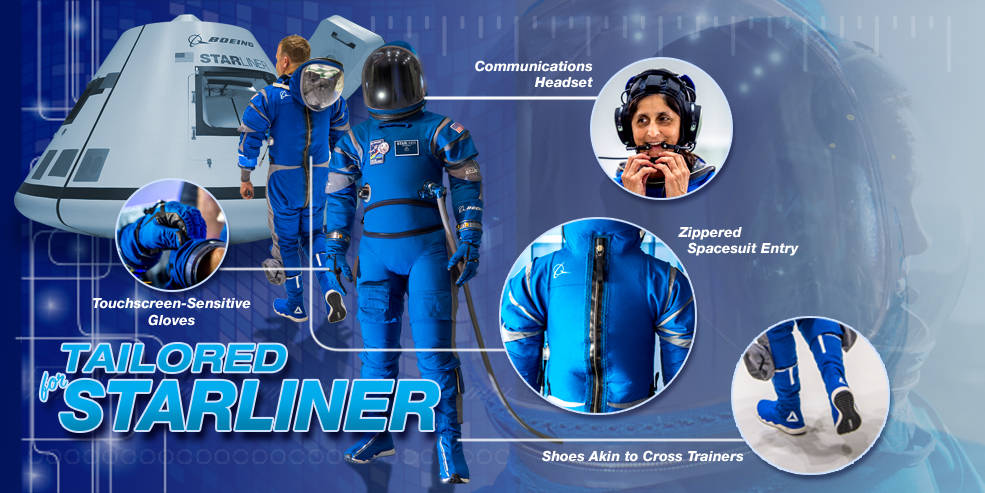Boeing introduced a spacesuit for the crew of the Starliner spacecraft

Boeing Corporation showed pictures of space suits intended for astronauts from the Starliner spacecraft. The new spacesuit was named "Boeing Blue". Representatives of the American company claim that it is more flexible than other spacesuits of this type and 40% lighter than other models. In addition, it is stated that the spacesuit will be able to hold the pressure and other parameters necessary for a person in the event of a ship depressurization.
Among its other features, a human-friendly shape, the ability to sit and stand, light weight and mittens that are suitable for working with a touch screen of electronic devices of any type are named. The helmet provides a wide viewing angle, so that the user's peripheral vision is also involved. The spacesuit developer is David Clark.

')
The company unveiled new spacesuits on Facebook Live. The partner of this event was the newspaper Washinton Post. The presentation was held at the John Fitzgerald Kennedy Space Center (eng. John F. Kennedy Space Center).
Space suits are good, but the exact date of astronauts sending into space on a spacecraft from Boeing has not yet been specified. Test flights of new American manned ships are scheduled for this year. We are talking about the Boeing CST-100 Starliner and SpaceX Dragon 2. These flights will be unmanned, and the manned missions will be completed (if everything goes according to plan) in 2018. Boeing had previously announced its intention to send a manned ship to the first test flight in August 2018. The expedition is planned to be sent to the ISS in December of the same year.

Kennedy Space Center in Florida, USA
Space launches will be carried out in accordance with the contract with NASA regarding the delivery of cargo and people to the ISS. According to this contract (or rather, two contracts - with SpaceX and Boeing), NASA guarantees at least four manned flights to the ISS. Who will fly first - Boeing or SpaceX, is still unknown.
The contracts themselves were signed a few years before the launch of the launches. This is done to ensure that contractor companies have the opportunity to create launch vehicles with testing their performance.
Under the terms of the contract with NASA, the cabin of the Boeing CST-100 Starliner must accommodate a crew of at least four people. Also in the cockpit, according to NASA requirements, it should be possible to place 100 kg of payload. The device must be able to remain docked to the station for 210 days in order to ensure the delivery of astronauts and astronauts to Earth, and, if necessary, to perform an emergency evacuation of the team. NASA believes that working with new Boeing and SpaceX ships will increase the station’s crew by up to seven people. This will increase the amount of time that can be devoted to scientific research.
The head fairing of a Boeing spacecraft will ensure that the capsule with the crew and the cargo will be streamlined; after exiting the atmosphere, the fairing will be separated from the rocket. On the rear panel of the fairing there is a docking station for docking with the ISS or other orbital stations that may appear in the future. The ship is controlled by three pairs of engines. Two are located on the sides for maneuvering, two - the main engines and two more - additional. Each capsule is equipped with two portholes: one in front and one in the side. If the fuel in the system separating the capsule and the launch vehicle is not used, it can then be spent in orbit. The capsule is planned to be used up to 10 times.
The spacecraft from Boeing consists of two modules. The first is the instrument and aggregator compartment. The second is the descent vehicle. The same ship, besides the ISS, will deliver astronauts to the Bigelow orbital complex. The CST-100 is designed for relatively short journeys. “100” in the name of the ship means 100 km or 62 miles of the Karman Line .
| No | Mission name | Date ( UTC ) | Crew | Logo | ||||
|---|---|---|---|---|---|---|---|---|
| launch | docking with ISS | time in docked condition with ISS | landings | on ISS | with ISS / | |||
| Scheduled | ||||||||
| one | Boe-oft (Orbital Flight Test) | June 2018 | - | - | ||||
| The first test flight of the CST-100 Starliner to the ISS (without crew); docking, 30-day mission, undocking and landing using parachutes are planned. | ||||||||
| 2 | Boe-CFT (Crew Flight Test) | August 2018 | 2 | 2 | ||||
| The second test flight of the CST-100 Starliner to the ISS (with crew); docking, 14-day mission, undocking and landing using parachutes are planned. | ||||||||
Source: https://habr.com/ru/post/370107/
All Articles